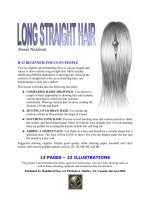Tài liệu One Point Perspective docx
Bạn đang xem bản rút gọn của tài liệu. Xem và tải ngay bản đầy đủ của tài liệu tại đây (436 KB, 6 trang )
PERSPECTIVE
Brenda Hoddinott
E-04 BEGINNER: PERSPECTIVE ONE
Realistic drawings become visually correct and more realistic when you use various components
of perspective. One-point perspective is the technique of using a single vanishing point to create
the illusion of a straight-on view into distant space. One point perspective occurs when the
frontal face of an object (such as a cube) is closer to you than its sides.
This lesson includes the following two sections:
Ü THE BASIC LANGUAGE OF PERSPECTIVE: Five basic terms are introduced to help
you understand the instructions used in this lesson. A drawing of a box, rendered with one-
point perspective, challenges you to gain insights into the process of drawing a three
dimensional form.
Ü DRAWING A THREE-DIMENSIONAL BOX: You discover how to transform a two-
dimensional shape into a three-dimensional form. You begin by drawing a horizon line and
vanishing point, and then use perspective lines to draw a simple box.
Suggested drawing supplies include drawing paper, pencils, erasers, and a ruler.
6 PAGES – 9 ILLUSTRATIONS
This article is recommended for artists of all ages and abilities, as well as home schooling,
academic and recreational fine art educators.
Published by Hoddinott Fine Art Publishers, Halifax, NS, Canada – 2005 (Revised 2006)
In this lesson, you use basic one
point geometric (also referred to
as linear) perspective to
transform a two-dimensional
square or rectangle into a three-
dimensional form.
Copyright to all articles, images, text, projects, lessons and exercises within this drawing class belong to Brenda Hoddinott and
may not be reproduced or used for any commercial purposes whatsoever without the written permission of Brenda Hoddinott.
Web sites:
-2 -
THE BASIC LANGUAGE OF PERSPECTIVE
To understand the instructions used in this lesson, you need to become familiar with the
following five terms.
Ü Geometric perspective (sometimes called linear perspective) is a method of representing
subjects in a drawing, in such a way that they seem to recede into distant space, and appear
smaller the farther they are away from you.
Ü Horizon line: is a horizontal line (invisible in real life) sometimes referred to as eye level,
which divides your line of vision when you look straight ahead. (Refer to illustration 04-01)
Your eye level and the horizon line are one and the same.
Look straight ahead (rather than up or down), and the horizon line is directly in front of you.
Wherever you go, from the top of the highest mountain, to the lowest valley, your eye level
always stays with you.
Ü One point perspective: occurs when the frontal face of an object (such as a cube) is closest
to you, and its edges recede in space and converge at a single vanishing point.
Ü Perspective lines: are lines (invisible in real life) that extend from the edges of objects and
recede into distant space until they finally seem to vanish at a point on the horizon line
known as the vanishing point. (Refer to illustration 04-01)
The perspective lines of objects below you angle upwards towards the horizon line and
converge at the vanishing point. Objects above you have perspective lines that angle
downward and also connect with a vanishing point.
Ü Vanishing point (VP): is the point on the horizon line where the straight lines of an object
converge and the object seems to disappear. (Refer to illustration 04-01)
Lines of objects, that are parallel or perpendicular (at a right angle) to the horizon line, don’t
appear to go back in space and therefore rarely meet the vanishing point.
Examine this drawing to gain insights into the process of drawing a three dimensional form.
Form, as applied to drawing, is the illusion of the three-dimensional structure of a shape, such as
a circle, square, rectangle, or triangle, created in a drawing with shading and/or perspective.
ILLUSTRATION 04-01
Copyright to all articles, images, text, projects, lessons and exercises within this drawing class belong to Brenda Hoddinott and
may not be reproduced or used for any commercial purposes whatsoever without the written permission of Brenda Hoddinott.
Web sites:
-3 -
DRAWING A THREE-DIMENSIONAL BOX
Realistic drawings become visually correct and more realistic when you use various components
of perspective. One-point perspective is the technique of using a single vanishing point to create
the illusion of a straight-on view into distant space.
In this section, you discover how to transform a two-dimensional shape into a three-dimensional
form. You begin by drawing a horizon line and vanishing point, and then use perspective lines to
draw a simple box.
1) Use your ruler to draw a horizon line that is parallel to the top and bottom of a square
or rectangular drawing space (press very lightly with your HB pencil).
2) Add a small dot on the horizon line to represent the vanishing point.
If you wish, you can mark it VP.
ILLUSTRATION 04-02
When using geometric perspective to draw a straight-on view of square
or rectangular shape, the horizontal lines need to be parallel to the horizon line and the
vertical sides need to be perpendicular (at a right angle).
3) Use an HB pencil to draw a rectangle or square slightly below the horizon line.
This rectangular or square shape represents the flat frontal face of a box and is closer to the
viewer than any of its other sides.
ILLUSTRATION 04-03
Copyright to all articles, images, text, projects, lessons and exercises within this drawing class belong to Brenda Hoddinott and
may not be reproduced or used for any commercial purposes whatsoever without the written permission of Brenda Hoddinott.
Web sites:
-4 -
4) Use a ruler to draw a straight line that connects the upper left corner of the square (or
rectangle) to the vanishing point (keep these lines very light).
ILLUSTRATION 04-04
5) Connect the upper right corner to the vanishing point with another straight line.
ILLUSTRATION 04-05
6) Connect the lower right corner to the vanishing point.
ILLUSTRATION 04-06
These three perspective lines, which
recede into space and converge at the
vanishing point, identify where to
draw the top and one side of the box.
Copyright to all articles, images, text, projects, lessons and exercises within this drawing class belong to Brenda Hoddinott and
may not be reproduced or used for any commercial purposes whatsoever without the written permission of Brenda Hoddinott.
Web sites:
-5 -
7) Using the perspective lines as guidelines, complete the outline of a box by drawing a
horizontal and vertical line (use a freshly sharpened HB pencil).
ILLUSTRATION 04-07
The horizontal line at the
top is parallel to the upper
edge of the rectangle (and
to the horizon line).
The vertical line, representing the rear side edge
of the box, is parallel to the sides of the rectangle
(and perpendicular to the horizon line).
8) Darken the angular lines of the box by outlining them with a freshly sharpened HB
pencil.
ILLUSTRATION 04-08
ILLUSTRATION 04-09
9) Erase the horizon line,
vanishing point, and
perspective lines with a
vinyl eraser.
You now have a properly
drawn, three dimensional
box.
One point perspective can
help you draw numerous
objects, including
buildings.









